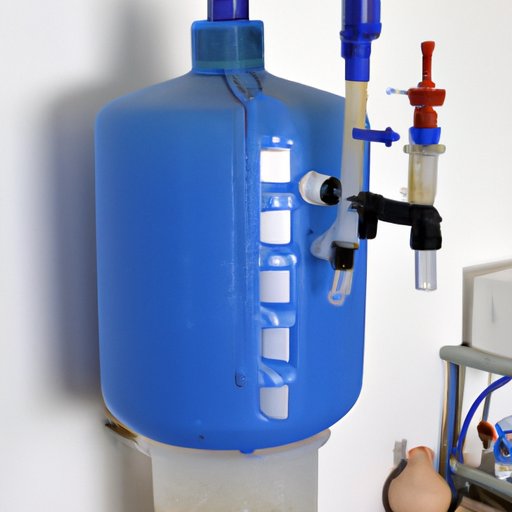Introduction
Iron is a naturally occurring element found in many parts of the world, including in well water. While iron is an essential mineral for human health, too much of it can cause problems. Iron in well water can create staining on fixtures, laundry, and other surfaces. It can also discolor drinking water and clog pipes. Fortunately, there are several ways to remove iron from well water.
Install an Iron Filter
One of the most popular methods of removing iron from well water is to install an iron filter. Iron filters come in several types, including greensand filters, birm filters, and multi-media filters. Greensand filters use potassium permanganate as an oxidizer to help break down iron, manganese, and hydrogen sulfide. Birm filters use a special type of media that helps remove iron, manganese, and sulfur. Multi-media filters use a combination of different media that can effectively remove iron, manganese, and other contaminants.
When installing an iron filter, it’s important to make sure that the filter is sized correctly for your needs. You should also ensure that the filter is installed according to the manufacturer’s instructions. Additionally, it’s important to regularly maintain the filter by backwashing it and replacing the media when necessary.
Use a Chlorination System
Another option for removing iron from well water is to use a chlorination system. Chlorination systems work by introducing chlorine into the water, which helps break down the iron molecules. Chlorine also helps keep bacteria and other contaminants out of the water. However, it’s important to note that these systems can produce potentially hazardous byproducts, so they should be used with caution.
When setting up a chlorination system, you should consult a professional to ensure that the system is properly installed and maintained. Additionally, you should have your water tested regularly to make sure that the chlorine levels remain safe.
Install an Aeration System
Aeration systems are another option for removing iron from well water. These systems work by injecting air into the water, which helps to oxidize the iron. Oxidized iron can then be filtered out of the water more easily. Aeration systems also help reduce odors, improve taste, and reduce the presence of harmful bacteria in the water.
When installing an aeration system, you should ensure that the system is properly sized for your needs and is installed according to the manufacturer’s instructions. Additionally, you should regularly check and maintain the system to ensure that it is functioning properly.
Utilize an Oxidation Method
Oxidation methods are another way to remove iron from well water. These methods involve adding an oxidizing agent to the water, such as chlorine or ozone. The oxidizing agent helps to break down the iron molecules, allowing them to be filtered out of the water more easily. Oxidation methods are often used in conjunction with other treatments, such as filtration or chlorination.
When using an oxidation method to remove iron from well water, it’s important to consult a professional to ensure that the system is properly installed and maintained. Additionally, you should test your water regularly to ensure that the levels of the oxidizing agent remain safe.
Try a Water Softener
Water softeners are another option for removing iron from well water. Water softeners work by exchanging calcium and magnesium ions for sodium ions, which helps to reduce the amount of iron in the water. Water softeners also help to reduce the buildup of scale in pipes and fixtures.
When installing a water softener, you should make sure that the system is properly sized for your needs. Additionally, you should regularly check and maintain the system to ensure that it is functioning properly.
Perform Reverse Osmosis Filtration
Reverse osmosis filtration is an effective method for removing iron from well water. This process involves forcing water through a semi-permeable membrane, which helps to remove impurities from the water. Reverse osmosis filtration can effectively remove iron, as well as other contaminants like lead, arsenic, and nitrates.
When installing a reverse osmosis filtration system, you should ensure that the system is properly sized for your needs and is installed according to the manufacturer’s instructions. Additionally, you should regularly check and maintain the system to ensure that it is functioning properly.
Use a Distillation System
Distillation systems are another option for removing iron from well water. These systems work by boiling the water and then condensing the steam, which helps to remove impurities from the water. Distillation systems are particularly effective at removing iron, as well as other heavy metals like lead and arsenic.
When installing a distillation system, you should ensure that the system is properly sized for your needs and is installed according to the manufacturer’s instructions. Additionally, you should regularly check and maintain the system to ensure that it is functioning properly.
Conclusion
Iron in well water can cause staining and clogging of pipes. Fortunately, there are several ways to remove iron from well water, including filters, chlorination, aeration, oxidation, softeners, reverse osmosis filtration, and distillation. When selecting a method, it’s important to consider your particular needs and budget. With the right solution, you can enjoy clean, clear, and safe water.
(Note: Is this article not meeting your expectations? Do you have knowledge or insights to share? Unlock new opportunities and expand your reach by joining our authors team. Click Registration to join us and share your expertise with our readers.)
